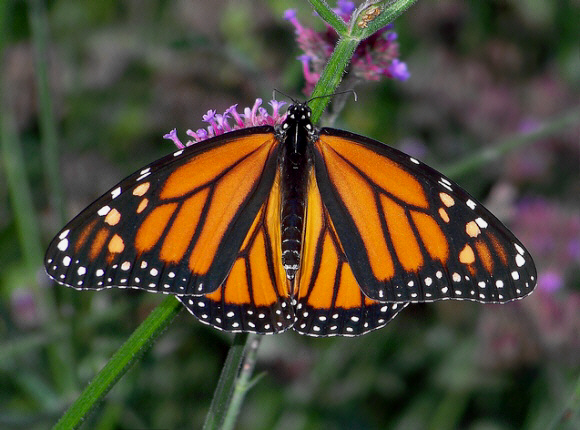
Danaus plexippus – final instar larva, Santa Fe de Antioquoia, Colombia – Adrian Hoskins
Introduction
The Monarch is the most famous migrant in the butterfly world. Its powers of migration are so great that it has been able to spread to across the Americas from Canada to Peru; across the Atlantic to Europe, Africa and India; and across the Pacific to Australia, New Zealand and Papua New Guinea. A detailed discussion of its migratory behaviour can be found on the Monarch migration page.
The Monarch has established 5 non-migratory subspecies in the neotropical region – portoricensis in Puerto Rico; leucogyne on the Virgin Islands; megalippe in Cuba, the Bahamas and the Caymans; tobagi on Tobago, and nigrippus in the Andes.
Danaus plexippus nigrippus is found on both sides of the Andes from Colombia to central Peru.
Habitats
In Ecuador the butterfly is mainly associated with severely disturbed areas of mid-elevation forest in the western Andes. In Peru I have found it mainly in valleys and gorges in the eastern Andes.
Lifecycle
The straw-coloured egg is barrel-shaped, with vertical keels, each of which is linked by numerous small horizontal ridges. It is laid singly on the underside of Asclepias leaves, and also occasionally on Calotropis ( Apocynaceae ). The mature larva is white, with each segment marked with narrow black and yellow bands. The 2nd thoracic segment and 8th abdominal segment each bear a pair of black whip-like protuberances. The larval foodplants contain toxins which can induce cardiac arrest in small vertebrates. The toxins are sequestered by the larvae and inherited by the adult butterflies which utilize them for defence against insectivorous birds and reptiles. The pale green chrysalis is plump and barrel-shaped, with the abdominal segments compressed. At its widest point there is a narrow abdominal band studded with yellow and black dots. It is suspended by a stout cremaster from stems on or near the foodplants.

Danaus plexippus – North American subspecies plexippus – Frank Model
Adult behaviour
The butterflies have a powerful but fluttering flight, interspersed with periods of soaring and gliding in wide circles as they fly from one clump of flowers to another. They settle frequently to nectar at Asclepias and other flowers.
Courtship takes place in late morning at which time the male pursues the female in flight, nudging and cajoling her until she settles, typically on a bush, where copulation takes place.
The bodies of all Danaines contain cardenolides derived from the larval foodplants. Any bird eating one is likely to be affected by vomiting, muscular spasms and visual disturbance. Birds are able to learn and remember the patterns and colours of toxic butterflies, so after suffering the unpleasant experience of eating one Monarch they are less likely to attack another. Consequently many other species ( Mullerian mimics ) have evolved similar patterns and colouration which help them evade predation. These mimics include a high number of tiger complex orange and black Ithomiines as well as other Danaines.
Additionally numerous palatable species ( Batesian mimics ) have evolved similar colours and markings which fool birds into believing that they are inedible.
